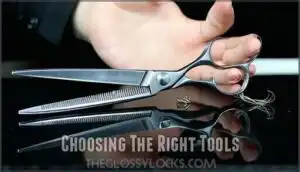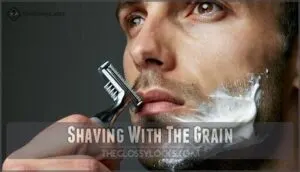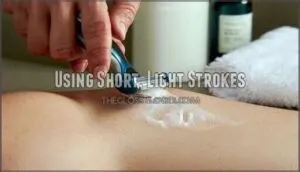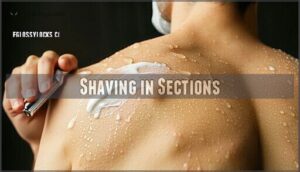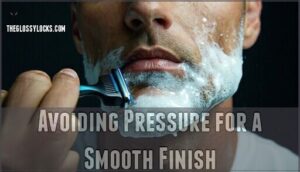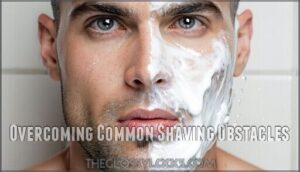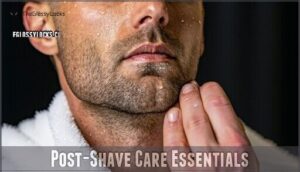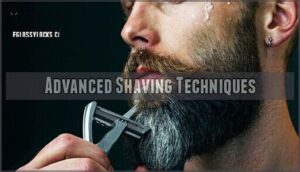This site is supported by our readers. We may earn a commission, at no cost to you, if you purchase through links.
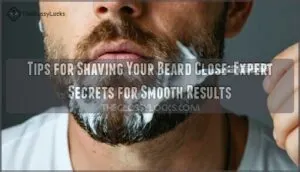
Always shave with the grain first using short, light strokes at a 30-degree angle. Let the razor do the work; pressing hard creates irritation, not closeness. For an even closer result, re-lather and make a second pass across the grain.
Keep your blade sharp—dull razors are your worst enemy. Finish with cold water to close pores, then apply aftershave balm. Master these fundamentals, and you’ll discover why most guys have been doing it wrong all along.
Table Of Contents
- Key Takeaways
- Preparing for a Smooth Shave
- Choosing The Right Tools
- How to Shave a Beard
- Mastering Shaving Techniques
- Overcoming Common Shaving Obstacles
- Shaving Safety Precautions
- Post-Shave Care Essentials
- Advanced Shaving Techniques
- Maintaining a Healthy Beard
- Solving Persistent Shaving Problems
- Frequently Asked Questions (FAQs)
- How to shave a beard?
- Why should you shave your beard?
- How do you shave a badger beard?
- How do you shave a beard with a procomfort?
- How do you shave your beard close?
- How do you get a super close shave?
- How to perfectly shave your beard?
- Why is my shave not close?
- How do I shave my beard without causing razor burn?
- Can I use regular soap instead of shaving cream?
- Conclusion
Key Takeaways
- Prep your beard properly – You’ll need warm water to soften whiskers, followed by pre-shave oil and quality shaving cream to create the perfect foundation for a close shave.
- Master the two-pass technique – You should always shave with the grain first using short, light strokes, then re-lather and make a second pass across the grain for maximum closeness.
- Use sharp blades and proper pressure – You can’t get a close shave with dull razors, and pressing hard creates irritation rather than closeness—let the blade do the work at a 30-degree angle.
- Finish with proper aftercare – You need to rinse with cold water to close pores, then apply an alcohol-free aftershave balm or moisturizer to prevent irritation and keep your skin smooth.
Preparing for a Smooth Shave
A close shave starts long before the razor touches your face, and getting your prep right makes all the difference between smooth skin and razor burn.
You’ll want to focus on three key steps: cleansing away dirt and oil, softening your beard hair, and trimming down longer whiskers that can clog your razor.
Cleansing and Exfoliating
Before you even touch a razor, start by washing your face with a gentle cleanser to remove dirt and oils. Cleanse your face thoroughly, then grab an exfoliating face wash or scrub.
Exfoliating before shaving is essential—it lifts dead skin cells and stubborn hairs, preventing ingrown hairs. Choose scrub types suited for sensitive skin if needed.
This skin preparation step makes your razor glide smoother and cuts cleaner.
Hydrating Your Skin
After cleansing and exfoliating, proper hydration becomes your next move. Hydrating Your Skin with warm water creates the perfect foundation for skin preparation and helps soften facial hair effectively.
Think of hydration as your shave prep breakthrough. When you splash warm water on your face, you’re setting up internal hydration that makes everything smoother.
Here’s what proper hydration delivers:
- Product Ingredients penetrate deeper into softened skin
- Sensitive Skin gets extra protection from razor irritation
- Nighttime Hydration repairs and strengthens your skin barrier
- Hydration Benefits include reduced friction and closer cuts
This simple step transforms tough stubble into manageable hair that your razor can handle with ease.
Trimming Down a Full Beard
With your skin properly hydrated, it’s time to tackle that full beard. Start with beard trimming tools set to a longer guard, working gradually shorter to avoid mistakes. Trim following your beard growth pattern for maintaining symmetry. Consider your beard shape options and style considerations as you reduce length. This gradual reduction approach prevents shock to your facial hair and sets perfect beard length goals before shaving your beard completely.
| Trimming Step | Action |
|---|---|
| Start Length | Use longest guard first |
| Direction | Follow natural growth pattern |
| Reduction | Go shorter gradually |
| Check Progress | Step back frequently |
| Final Prep | Switch to safety razor |
Choosing The Right Tools
The right tools make the difference between a rough morning struggle and a smooth, comfortable shave that leaves your skin feeling great.
You’ll want to match your razor, cream, and brush to your specific skin type and beard texture for the best results.
Razors for Different Skin Types
Now that you’ve prepped your skin, picking the right razor becomes your secret weapon for a smooth shave. Your skin type dictates which blade will treat you like royalty or leave you looking like you wrestled with a cat.
Sensitive Skin: The Braun Series 9 Pro electric razor or Gillette SkinGuard cartridge razors minimize irritation with protective guards and gentle foils.
Dry Skin: Schick Hydro Dry Skin razor features rice bran oil-infused gel pools that moisturize for hours after shaving.
Oily Skin: Multi-blade cartridge razors like the Merkur 39C provide precision cuts through dense growth.
Acne-Prone: Two-blade cartridge razors cause less irritation. Try Gillette Trac II or mild safety razors.
Combination Skin: BIC Flex 5 Hybrid balances multiple blade technology with lubricating strips.
Sharp blades matter most—dull razor blades tug and irritate regardless of type. Electric razors work great for convenience, while straight razors offer supreme control for experienced shavers. To avoid this, replace razor blades regularly for ideal results.
Shaving Creams and Soaps
Once you’ve selected your razor, your shaving cream or shave soap becomes your skin’s best friend. Cream vs soap comes down to personal preference—shaving soap creates dense, protective lather, while shave cream offers convenient application.
Look for ingredient benefits like glycerin, shea butter, or coconut oil that hydrate skin. Sensitive skin needs fragrance-free formulas to avoid irritation. Lather quality matters most—thick, cushioning foam protects better than thin shave gel.
Application methods vary: work soap with circular motions using warm water, or squeeze cream directly onto damp skin. Quality lather should feel slick and protective, creating the perfect glide. For those with sensitive skin, traditional creams offer benefits.
Brushes for a Smooth Shave
When you’re ready to level up your shave, a shaving brush becomes your secret weapon. Badger hair holds water better, while boar bristles provide exceptional exfoliation benefits.
Here’s how to enhance your brush types for lather quality:
- Soak brush in warm water for 30 seconds
- Load cream using circular motions for 10-15 seconds
- Work lather on face in circular patterns to lift hairs
- Rinse thoroughly and air-dry for proper brush maintenance
- Choose softer bristles if you have sensitive skin
This simple upgrade transforms ordinary cream into rich, protective lather that delivers a shaving brush close shave. Exploring different brush materials can substantially impact your shaving experience.
How to Shave a Beard
Now you’re ready to put your preparation to work and transform that beard into a smooth, close shave. The key lies in mastering three essential techniques that work together to give you professional results without the irritation.
Shaving With The Grain
With your tools now ready, grain mapping becomes your first priority for achieving that smooth shave you’re after. Think of your beard like a field of wheat – every hair has its own direction. Minimize irritation by following nature’s blueprint instead of fighting against it. Run your hand across your face when it’s dry to feel which way your whiskers naturally grow.
Your first pass should always respect this hair direction. Here’s your roadmap:
- Cheeks and neck – stroke downward with gentle motions
- Chin area – move sideways following the natural grain pattern
- Upper lip – use controlled downward movements
Avoiding pressure is key here. Let the razor do the work while you guide it along the natural path. This technique sets you up for a close shave without the angry red aftermath. Your skin will thank you later.
Using Short, Light Strokes
Short, controlled movements prevent razor burn and give you better pressure control. Keep your stroke length around one inch—think of gentle brushstrokes on canvas. Maintain that 30-degree razor angle while letting the blade glide smoothly.
This technique works especially well for areas with high hair density or skin sensitivity. Your shaving techniques should prioritize light strokes over speed for the perfect close shave when shaving your beard close. To further minimize irritation, consider shaving with the grain.
Re-lathering and Shaving Across The Grain
Why settle for just close when you can achieve baby-smooth flawlessness? After your first pass, re-lather generously to maintain lather consistency and protect your skin.
Now comes the second pass—carefully shave across the grain, adjusting your blade angle for grain variations. This close shave technique dramatically reduces stubble but increases irritation risk.
Master these sophisticated shaving techniques gradually, especially when shaving your beard close requires patience and precision.
Mastering Shaving Techniques
Once you’ve got the basics down, mastering a few key techniques will take your shave from decent to barbershop-quality.
These methods help you get that smooth, close finish without turning your face into a battleground.
Stretching The Skin for a Closer Shave
Mastering skin stretching transforms your shave from good to outstanding. Your free hand becomes your secret weapon here.
Skin Tension is everything when shaving your beard close. Pull your skin taut to create that perfect Smooth Surface for your blade.
Here’s how to nail the technique:
- Use your non-dominant hand for Hand Placement control
- Stretch skin opposite to your razor’s direction
- Maintain steady Blade Angle while pulling
- Keep tension consistent throughout each stroke
This skin stretching method eliminates wrinkles and bumps that cause nicks. Think of it like smoothing out a bedsheet before making it. The tighter surface lets your razor work efficiently, delivering that close shave you’re after while helping Prevent Irritation. Master these shaving techniques and you’ll wonder why you ever shaved without stretching.
Shaving in Sections
With your skin properly stretched, you can now work smarter by breaking your face into manageable zones. Think of your beard as a neighborhood map – tackle the cheeks first, then move to the jawline, chin, and neck.
This sectioning approach gives you controlled passes and efficient coverage without missing spots. Each area gets your full attention, preventing the overlap that causes irritation. Precision shaving becomes second nature when you’re not rushing around your entire face at once.
Avoiding Pressure for a Smooth Finish
You don’t need to wrestle your razor like you’re arm-wrestling your brother. Pressure control is the secret to achieving that coveted smooth shave without turning your face into a battlefield. Think of your razor as a precision instrument, not a bulldozer. The blade sharpness does most of the heavy lifting, so let it glide smoothly across your skin. When you apply too much pressure, you’re basically forcing the blade to dig deeper than necessary, which leads to skin sensitivity issues and those dreaded razor bumps.
Let your razor glide like a feather, not bulldoze like a tank
Master these shaving techniques for ideal razor glide:
- Use gentle strokes with just enough contact to cut the hair
- Let the razor’s weight provide natural cutting force
- Maintain consistent light strokes throughout each pass
The key is trusting your technique. Quality gentle strokes combined with proper pressure control will deliver that baby-smooth finish you’re after. Your skin will thank you, and you’ll wonder why you ever thought shaving had to feel like medieval torture.
Overcoming Common Shaving Obstacles
Even the most experienced shavers face frustrating challenges that can ruin an otherwise perfect shave. You’ll learn how to tackle razor burn, handle sensitive skin, and conquer stubborn coarse hair with proven techniques that work.
Razor Burn and Ingrown Hairs
Even with perfect shaving techniques, you might face razor burn and ingrown hairs. These issues aren’t your fault—they happen to everyone seeking a close shave.
Preventative Measures work best. Use a sharp razor blade and shave with the grain first. Identifying Causes helps too: dull blades, dry skin, and rushing create problems.
For Treatment Options, try gentle exfoliation for ingrowns. Soothing Irritation requires cool compresses or aloe vera. Check Product Ingredients—avoid alcohol-based aftershaves that sting.
Problem Prevention Treatment
Sensitive Skin Solutions
If razor burn has you feeling defeated, don’t worry—sensitive skin doesn’t mean giving up on that perfect close shave. Your skin needs extra care, but the right approach makes all the difference.
Start with gentle exfoliation using a soft scrub to prep your face without irritation. Hypoallergenic products are your best friends here—they won’t trigger reactions like regular formulas might. Choose a shaving cream with soothing ingredients like aloe or chamomile that create a protective barrier.
Your razor choice matters tremendously. Single-blade razor blades reduce irritation by up to 50% compared to multi-blade options that can drag across sensitive skin. After shaving, skip alcohol-based products and reach for aftershave alternatives like a gentle balm.
Here’s what works for sensitive skin:
- Fragrance-free cleansers that won’t strip natural oils
- Hydrating creams with protective barriers
- Alcohol-free aftershave balm to calm inflammation
- Sharp, clean blades changed frequently
- Cool water rinses to tighten pores
Take your time and listen to your skin’s feedback.
Dealing With Coarse or Curly Hair
Coarse hair presents unique challenges when shaving your beard close. Hair Texture Matters – thick strands resist cutting and increase razor burn risk.
Start with Pre-shave Softening using warm water and quality oils. Blade Choice counts: sharp, single-blade razors work best for coarse hair. Use proper Shaving Techniques with short strokes following the grain direction. Shaving Frequency should match your hair growth.
Finish with Post-shave Hydration to prevent ingrown hairs. To help prevent ingrown hairs, consider exfoliating skin beforehand.
Shaving Safety Precautions
Safety isn’t just about avoiding cuts—it’s about creating the right conditions for a smooth, irritation-free shave every time.
When you prioritize proper technique and use the right tools, you’ll get better results and keep your skin happy.
Using a Sharp Razor Blade
Sharp razor blades are your ticket to smooth results without the drama. A dull blade tugs at hair like a rusty lawnmower, creating irritation and nicks.
A sharp blade cuts whiskers effortlessly while dull blades drag and destroy your skin
Check Blade Sharpness Levels by listening—sharp blades whistle through hair, while dull ones drag and pull. Razor Blade Materials matter too. Stainless steel holds its edge longer than basic carbon steel.
For Blade Replacement Frequency, swap cartridges after 5–7 shaves or when you feel resistance. Storing Razor Blades properly extends their life—keep them dry and away from humidity.
Skip Sharpening Razor Blades at home; it’s trickier than it looks. Instead, invest in quality sharp razor blades and replace them regularly. Your face will thank you.
Avoiding Pressing Too Hard
Against popular belief, more pressure doesn’t deliver a close shave—it creates razor burn and irritation. Your blade sharpness manages the cutting while gentle strokes protect skin sensitivity. Focus on pressure control to let the razor glide smoothly with minimal friction.
Here’s your shaving techniques playbook:
- Use the razor’s natural weight—no added force needed
- Apply light strokes like you’re painting delicate artwork
- Think smooth gliding motion, not aggressive scraping
Remember: sharp blades cut whiskers effortlessly, so trust the process.
Preventing Cuts and Nicks
Mastering nicking prevention starts with understanding your blade angle. Keep it at 30 degrees for ideal razor sharpness without aggressive contact. Skin stretching creates a taut surface that prevents cuts while enabling precise short strokes.
| Risk Factor | Prevention Method |
|---|---|
| Dull blade | Replace every 5-7 shaves |
| Poor angle | Maintain 30-degree contact |
| Rushing | Take deliberate, controlled passes |
Your shaving safety precautions should include keeping a styptic pencil nearby. When razor blade sharpness diminishes, you’re more likely to press harder, increasing nicking your skin risk. Remember: your blade should glide smoothly. If you’re fighting resistance, it’s time for a fresh edge.
Post-Shave Care Essentials
You’ve just finished shaving, but your work isn’t done yet—proper post-shave care makes the difference between smooth skin and hours of irritation. The right steps after putting down your razor will lock in your close shave and keep your skin healthy for days to come.
Rinsing With Cold Water
Splash cold water on your face right after your close shave to lock in that smooth finish. This simple step triggers pore closure and skin tightening while boosting circulation for healthier skin.
Here’s what cold water does for your shaving routine:
- Pore Closure – Seals open pores to prevent dirt and bacteria from entering
- Inflammation Reduction – Calms irritated skin and reduces post-shave redness
- Circulation Boost – Increases blood flow for faster healing and recovery
- Aftershave Alternative – Provides natural soothing without harsh chemicals
Applying Aftershave Balm
Your skin craves immediate relief after that close shave. Aftershave balm delivers the perfect postshave care your face needs. Here’s your Application Technique for maximum comfort:
- Balm Ingredients matter – choose alcohol-free formulas with aloe or chamomile
- Skin Type compatibility guarantees no irritation or breakouts
- Scent Preferences should complement your daily routine without overwhelming
- Balm Alternatives like moisturizer work if you’re out of aftershave
Consider using alcohol free options for sensitive skin. Apply gently with upward motions for effective skin care.
Moisturizing for Soothing and Protection
After shaving, moisturizing becomes your skin’s best friend. Choose a lightweight moisturizer with SPF for sun protection and hydration benefits. Look for balm ingredients like aloe or chamomile that calm sensitive skin and strengthen your skin barrier.
Apply it to damp skin using gentle pats—this locks in moisture better than rubbing. Think of it as your nighttime routine’s perfect partner, working alongside your shaving cream and aftershave balm to keep your face comfortable all day.
Advanced Shaving Techniques
Once you’ve mastered the basics, it’s time to take your shaving game to the next level with sophisticated techniques.
These expert methods will help you achieve that barbershop-quality finish right at home.
Shaving Across The Grain for a Closer Shave
When you’re ready for that ultra-smooth finish, shaving across the grain delivers closer shave results than your first pass. After shaving your beard with the grain, map your hair’s direction carefully.
Make your second pass perpendicular to growth patterns using the multi-pass shaving technique. Keep your blade angle consistent and use gentle pressure—irritation prevention tips start with light strokes.
Watch for skin sensitivity concerns and closer shave risks like razor burn. This sophisticated shaving technique requires finesse over force for professional results.
Using a Shaving Brush for a Rich Lather
Transform your shave with the right shaving brush. Quality bristles create rich, protective lather that lifts whiskers and cushions skin better than your hands ever could. The secret lies in proper application technique and choosing between brush types.
- Badger bristles hold more water for creamier lather with shaving soaps
- Circular motions followed by painting strokes guarantee even coverage
- Brush maintenance includes thorough rinsing and upright drying for longevity
Edging and Defining for a Finished Look
Once you’ve built that rich lather, it’s time for the finishing touches. Grab your single-blade razor or precision trimmer for beard line precision. Pull your skin tight while shaping your cheek line and defining that neckline maintenance. Work slowly around your moustache definition and sideburn sculpting.
Create clean angles by following your natural contours—think subtle U-shape for your neckline. Remember, less is more with these shaving techniques. You can always trim more off your beard, but growing it back takes weeks.
Maintaining a Healthy Beard
You can’t maintain a healthy beard by ignoring it between close shaves. Keep your razor clean and manage regrowth properly to avoid skin problems and get better results next time.
Trimming and Grooming Between Shaves
Between shaves, your beard needs attention to stay sharp and manageable. Regular length maintenance keeps your beard shape defined while preventing unruly growth. Use quality beard trimming tools like an electric trimmer for precise stubble management and neckline upkeep.
Here’s your grooming routine:
- Apply beard oil daily to soften hair and nourish skin
- Trim every 3-4 days to control beard growth patterns
- Use styling products for consistent texture and hold
- Clean up stray hairs around edges for a polished appearance
This approach makes your next close shave smoother and more comfortable.
Sanitizing Your Razor for a Clean Shave
Keeping your razor clean isn’t just good hygiene—it’s shaving safety precautions at their finest. After each shave, rinse your blade thoroughly under hot running water to remove hair and debris. For deeper razor sanitation methods, soak the blade in rubbing alcohol weekly, preventing infections from bacterial buildup.
This cleaning frequency guarantees superior razor blade care. Always pat your razor dry completely before storage in a cool, dry spot. Proper razor storage and disinfectant types like isopropyl alcohol extend your blade’s life while protecting your skin from nasty surprises.
To maintain hygiene, consider disinfecting razor basics to prevent bacterial infections.
Managing Beard Growth and Regrowth
Beyond keeping your razor clean, managing your beard growth becomes your next priority after shaving your beard close. Your Growth Rate Factors determine how often you’ll need to shave your face. Here’s how to stay ahead of stubble:
- Track your Patchy Beard Fixes and growth patterns weekly
- Maintaining Shape requires trimming every 5-7 days
- Apply Encouraging Growth oils to nourish follicles
- Plan Styling Regrowth strategies for uneven areas
Understanding your beard’s unique timeline helps you maintain that smooth finish longer.
Solving Persistent Shaving Problems
Even with perfect technique, some guys still battle stubborn ingrown hairs and razor burn that just won’t quit. When your usual tricks aren’t working, it’s time to try sophisticated solutions or get advice from a professional barber who’s seen it all.
Addressing Ingrown Hairs and Razor Burn
When razor burn and ingrown hairs crash your smooth shave party, don’t panic. Preventative exfoliation before shaving lifts trapped hairs and clears dead skin. Proper hydration softens whiskers, making them easier to cut. Follow your shaving direction—always with the grain first.
Razor maintenance matters: dull blades tug and irritate skin. Your aftercare routine should include cold water rinses and alcohol-free balm. For razor burn treatment, try aloe vera or cold compresses. These steps effectively prevent ingrown hairs and keep your skin happy.
Seeking Professional Advice From a Barber
Sometimes persistent problems call for professional help. A barber consultation offers customized solutions your home routine can’t match. Professional barbers assess your skin type and shaving techniques, then create a customized regimen suited to your needs.
They’ll demonstrate expert techniques for shaving your beard and provide product recommendations that actually work for your skin. This shaving education includes proper blade angles, shaving routine adjustments, and troubleshooting persistent issues. One key is to make certain you’re using quality shaving products to minimize irritation.
Watch them work and ask questions – their hands-on guidance transforms your close shave approach. Professional shaving tips beat trial-and-error every time.
Frequently Asked Questions (FAQs)
How to shave a beard?
Start by softening your beard with warm water or a hot towel. Apply pre-shave oil, then shave with the grain using short, light strokes. Rinse with cold water and moisturize afterward.
Why should you shave your beard?
Like trimming a garden hedge, you’ll want a clean slate for professional appearances, hygiene, or simply changing your look. Fresh starts matter whether it’s job interviews or personal reinvention.
How do you shave a badger beard?
I need to clarify your question. "Badger beard" usually refers to a beard with gray and dark mixed coloring, not an actual badger. You’d shave it using standard techniques: soften with warm water, use a sharp razor with light strokes following the hair grain, then moisturize afterward.
How do you shave a beard with a procomfort?
Use a Gillette ProComfort razor with fresh blades. Prep your beard with warm water, then apply quality shaving cream. Shave with the grain using gentle strokes, rinse frequently, and finish with cold water rinse.
How do you shave your beard close?
Like John’s morning ritual, you’ll want warm water to soften whiskers first. Apply pre-shave oil, then shave with the grain using short strokes. Stretch skin gently, rinse with cold water, and finish with moisturizer for smoothness.
How do you get a super close shave?
Prepare your face with warm water and pre-shave oil.
Shave with the grain using short strokes, then carefully shave across the grain for maximum closeness.
Finish with cold water and moisturizer.
How to perfectly shave your beard?
Start with a hot shower to soften whiskers, then apply pre-shave oil. Use a sharp razor at thirty degrees, shaving with the grain in short strokes. Stretch skin gently, rinse with cold water, and finish with moisturizing balm.
Why is my shave not close?
Your blade’s probably dull, you’re not prepping properly, or you’re rushing through passes. Sharp razors, warm water prep, and multiple careful passes with proper lather make all the difference.
How do I shave my beard without causing razor burn?
Razor burn feels like your face caught fire, but you can avoid it completely.
Prep with warm water, use sharp blades, shave with the grain using light strokes, and finish with cold water plus moisturizer.
Can I use regular soap instead of shaving cream?
You shouldn’t use regular soap for shaving. It doesn’t provide enough lubrication and can dry out your skin, leading to razor burn and irritation.
Invest in proper shaving cream or gel instead.
Conclusion
Mastering these tips for shaving your beard close is like learning to ride a bike—once you’ve got it down, you’ll wonder how you ever struggled before. Your skin will thank you for using proper technique instead of brute force.
Remember to prep well, use sharp blades, and don’t rush the process. With consistent practice of these methods, you’ll achieve that smooth, professional finish every time.
- https://www.gq.com/story/how-to-shave
- https://gillette.com/en-us/shaving-tips/how-to-shave/how-to-shave-your-face
- https://www.reddit.com/r/everymanshouldknow/comments/1c1qkoj/emskr_how_to_achieve_a_truly_clean_shave_for_the/
- https://aambarbershop.com/mastering-the-art-of-the-perfect-shave-tips-from-all-about-men-barbershop/
- https://www.nytimes.com/wirecutter/reviews/best-beard-trimmer/

